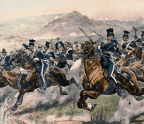REBEL WITH A LOST CAUSE


The army stood in silence as its general, a battle-hardened Roman veteran and proconsul, glared down on them. His remaining eye burned with intelligence and purpose, and his scarred face proclaimed his tenacity. In combat he was as strong and sharp as iron. With tactics he was as flexible as a bending reed. The wild Iberian tribesmen he led revered him, and they were unified as never before. Thousands vowed, should he perish in battle, to continue to fight until all had died with him, their blood spilled as a libation to his spirit.
Perhaps their general had called the assembly to chastise them, for they had departed from the lessons he had taught them. Inflated with increased numbers, swollen with the pride of past success and impatient with the measured tactics that had produced them, they had rashly engaged the enemy, being saved from disaster only by the intervention of the commander who had sought to restrain their reckless haste.
Quintus Sertorius had two horses brought into the field dividing the ranks. One of the beasts was old, feeble and lean, the other robust and grand. Beside the nag stood a tall, strong man, while beside the vigorous charger waited another, small and frail. At the motion of the general’s hand the brawny man took hold of the weak horse’s tail with both hands, as if to tear it free. The scrawny man, meanwhile, patiently plucked hairs one by one from the great steed’s tail. Though the efforts of the strong man excited much mirth, they proved fruitless, while the patient labor of the other in time stripped every strand. The lesson was clear: Forces that cannot be overcome when
You’re reading a preview, subscribe to read more.
Start your free 30 days



